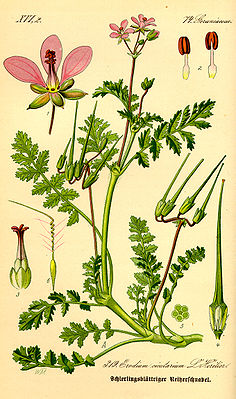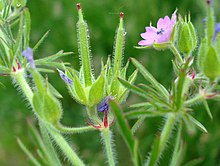Cranesbill family
| Cranesbill family | ||||||||||||
|---|---|---|---|---|---|---|---|---|---|---|---|---|

Common herons beak ( Erodium cicutarium ), illustration. |
||||||||||||
| Systematics | ||||||||||||
|
||||||||||||
| Scientific name | ||||||||||||
| Geraniaceae | ||||||||||||
| Yuss. |
The cranesbill family (Geraniaceae) are a family in the order of the cranesbill-like (Geraniales) within the flowering plants . Some species and hybrids are used as ornamental plants . Some species are grown for the production of pharmaceutical and cosmetic products.
The species-richest genera are cranesbills ( Geranium ), pelargoniums ( Pelargonium ) and herons' beaks ( Erodium ). Most of the species in the family come from temperate or warm climates , they are most common in southern Africa and are an important part of the Cape flora .
description
Habit and leaves
Most species grow as annual or perennial herbaceous plants , rarely are subshrubs or shrubs . Some species are succulent . They contain essential oils .
The upper leaves are mostly alternate, the lower ones are mostly opposite. The stalked, mostly hairy leaves are simple or compound; mostly lobed to divided. The stipules are deciduous, scale-shaped or prickly.
Inflorescence and flower
The flowers are solitary or mostly grouped together in axillary or terminal, simple or compound, zymous or dold-like inflorescences . The inflorescences usually have long inflorescence shafts and often contain bracts .
Most of the flowers are hermaphroditic, rarely unisexual; there are dioecious separate-sexed ( dioecious ) species. The stalked, five-fold flowers are radially symmetrical or zygomorphic with double perianth . The five sepals each are usually free or at most fused with tubes at their base. The five petals are mostly free and nailed. There are usually one or two (rarely three) circles with five stamens each, usually all are fertile or one to five are reduced to staminodes . The stamens are often fused at their base. Five carpels have become a top permanent ovary grown. There are only one or two ovules per carpel , with only one developing later. The upper sterile parts of the carpel, called the stylus , are fused to the tip and form the "beak" with five scars. Nectaries are present in all species. There are always five nectar glands. The only exception is the genus Pelargonium , which has only one nectar gland. The nectaries are formed from the flower base. The position of the nectaries is fixed within the family; they stand in front of the sepals and the inner circle of stamens.
fruit
When ripe, only the inner parts of the carpels remain as a central column ( carpophor ). The outer parts, which as part of the fruit each enclose a seed at the bottom, detach with their long awns from bottom to top. The fruit is a split fruit , the five partial fruits are solitary capsule fruits .
Naming
All taxa have a narrow beak-like structure at the top of the fruit, which is why three of the genera and the family were named after long-beaked birds (Aves). The name of the genus Geranium is derived from the Greek word geranos for " crane ", Pelargonium comes from the Greek pelargos for " stork " and Erodium from the Greek erodios for " heron ". In German, however, the genus Geranium is referred to as cranesbill and pelargoniums ( Pelargonium ) are often referred to as geraniums. The latter is due to the fact that Linnaeus , on which the nomenclature of flowering plants essentially goes back, added the pelargoniums of the genus Geranium . It was only when numerous South African pelargoniums were introduced in the 18th century that the famous amateur botanist Charles Louis L'Héritier de Brutelle was able to assert himself by recognizing pelargonium as an independent genus. At this point in time, however, the term “geranium” for the pelargonium species had already become commonplace. One of the differences between the two genera is: Geranium has radial symmetry flowers and Pelargonium has zygomorphic flowers.
Radially symmetrical flowers of Geranium cinereum .
Flower diagram of Pelargonium zonale .
Systematics and genres
Some authors also include the species of Biebersteiniaceae , Dirachmaceae , Ledocarpaceae and Vivianiaceae in the Geraniaceae family.
The Geraniaceae family contains five to six genera with 750 to 805 species . They differ, for example, in the number of fertile stamens per flower.
-
California
Aldas., Navarro, Vargas, Sáez & Aedo : There is only one type:
- California macrophylla Aldas., Navarro, Vargas, Sáez & Aedo : It only colonizes western North America. It has radial symmetrical flowers.
- Heron-beak ( Erodium L'Hér. ): The 74 to 80 species have a center of biodiversity in the Mediterranean . They have radial symmetry flowers and two circles with five stamens each, but some of them are reduced to staminodes.
- Cranesbills ( Geranium L. , Syn .: Geraniopsis Chrtek , Neurophyllodes (A.Gray) O.Deg. ): With around 400 to 430 species, it is the most species-rich genus of the family with an almost worldwide distribution. They have radial symmetry flowers and two circles with five fertile stamens each.
- Hypseocharis J.Rémy : With one to three species in subalpine habitats of the central, southwestern Andes . Perhaps a separate Hypseocharitaceae Weddell family.
- Monsonia L .: The 39 or so species are distributed in Africa and southwest Asia. They have radial symmetry flowers. Today including the former genus Dickstängel ( Sarcocaulon (DC.) Sweet ), which has been downgraded to the rank of a section : With three circles of five fertile stamens each.
- Pelargonium ( Pelargonium L'Hér. , Syn .: Campylia Lindl. Ex Sweet , Cortusina (DC.) Eckl. & Zeyh. , Hoarea Sweet , Isopetalum Sweet , Jenkinsonia Eckl. & Zeyh. , Ligularia Eckl. & Zeyh. , Myrrhidium ( DC.) Eckl. & Zeyh. , Otidia Lindl. Ex Sweet , Peristera (DC.) Eckl. & Zeyh. , Phymatanthus Lindl. Ex Sweet , Polyactium (DC.) Eckl. & Zeyh. , Seymouria Sweet ): There are about 270 species with the center of biodiversity in the Capensis, especially in the Karoo and KwaZulu-Natal ; but some species are also found in East Africa , Australia , Madagascar , on St. Helena and Tristan da Cunha . They have zygomorphic flowers. With types and varieties of popular bedding and balcony plants , house plants and scented plants .
More pictures
Typical cranesbill-shaped fruits using the example of Pelargonium capitatum .
Flowers of Erodium manescavi .
Habitat , habitus , flower and fruit of Erodium texanum .
Flower of Sarcocaulon crassicaule .
swell
- The Geraniaceae family at mobot.org (Systematics section).
- The Geraniaceae family at delta-intkey.com (Description section).
- Langran Xu, Carlos Aedo: Geraniaceae in the Flora of China. Volume 11, p. 8: the same text online as the printed work. (Section description).
- Omar Fiz, Pablo Vargas, Marisa Alarcón, Carlos Aedo, José Luis García, Juan José Aldasoro: Phylogeny and Historical Biogeography of Geraniaceae in Relation to Climate Changes and Pollination Ecology . In: Systematic Botany . tape 33 , no. 2 , 2008, p. 326–342 , doi : 10.1600 / 036364408784571482 (sections systematics and description).
Individual evidence
- ↑ Julius Jeiter, Hartmut H. Hilger, Erik F. Smets, Maximilian Weigend: The relationship between nectaries and floral architecture: a case study in Geraniaceae and Hypseocharitaceae . In: Annals of Botany . tape 120 , no. 5 , November 10, 2017, ISSN 0305-7364 , p. 791-803 , doi : 10.1093 / aob / mcx101 .
- ↑ Geraniaceae in the Germplasm Resources Information Network (GRIN), USDA , ARS , National Genetic Resources Program. National Germplasm Resources Laboratory, Beltsville, Maryland.
- ↑ JJ Aldasoro, C. Navarro, P. Vargas, LI Sáez, C. Aedo: California, a new genus of Geraniaceae endemic to the southwest of North America. In: Anales del Jardín Botánico de Madrid , Volume 59, 2002, pp. 209–216 ( redalyc.uaemex.mx ( memento of the original of September 13, 2008 in the Internet Archive ) Info: The archive link was inserted automatically and has not yet been checked. Please check the original and archive link according to the instructions and then remove this note. PDF).
literature
- Peter F. Yeo: Geranium , Stuttgart 1988
Web links
- Profile of the family of the Tübingen Botanical Garden. ( Memento from January 6, 2013 in the web archive archive.today )
- Description of the family from the Botanical Institute of the University of Ulm.








